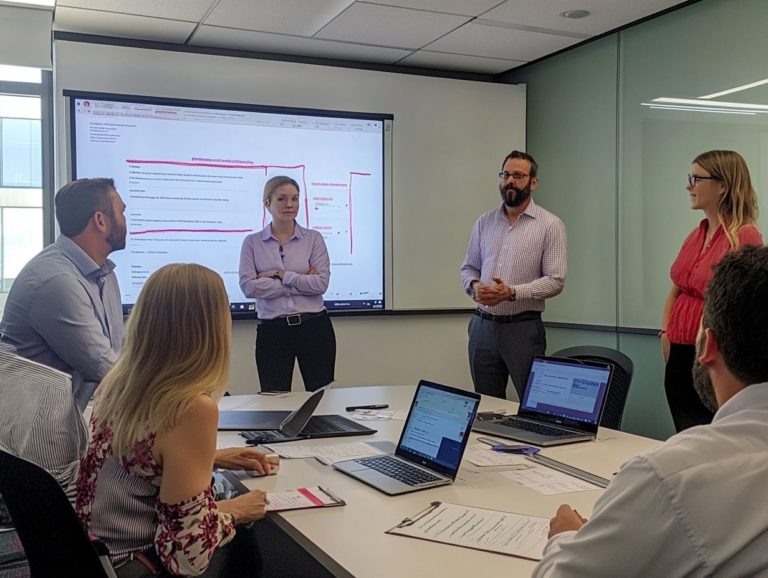Choosing Cloud-Based Performance Management Solutions
In today’s fast-paced business landscape, organizations are increasingly embracing cloud-based performance management solutions to elevate their operations.
These advanced tools deliver compelling benefits such as enhanced efficiency, substantial cost savings, and the flexibility to scale as your needs evolve.
When selecting the right solution, it’s crucial to evaluate factors like security, integration, and user experience.
This article delves into the advantages of these systems, highlights essential considerations during the selection process, and outlines steps for successfully implementing your chosen solution.
Explore how cloud-based performance management can revolutionize your organization’s approach to performance tracking and improvement.
Contents
- Key Takeaways:
- Benefits of Using Cloud-Based Performance Management Solutions
- Factors to Consider When Choosing a Cloud-Based Performance Management Solution
- Steps to Implementing an Online Performance Management System
- FAQs
- What are cloud-based performance management solutions?
- What are the benefits of choosing cloud-based performance management solutions?
- How do I choose the right cloud-based performance management solution for my business?
- What factors should I consider when evaluating cloud-based performance management solutions?
- Are there any drawbacks to using cloud-based performance management solutions?
- Can I switch to a different cloud-based performance management solution in the future?
Key Takeaways:
- These solutions offer efficiency and cost savings by eliminating the need for on-premise hardware and reducing maintenance expenses.
- Flexibility and scalability allow easy adaptation to changing business needs and growth.
- Consider security, data privacy, integration with existing systems, and customization for user-friendliness when choosing a solution.
What are Cloud-Based Performance Management Solutions?
Cloud-Based Performance Management Solutions are software systems designed to elevate employee performance. They equip you with tools for goal tracking, continuous feedback, and comprehensive performance reviews.
For small businesses aiming to refine HR processes and boost employee engagement, these tools offer structured check-ins and powerful analytics. With cloud access, you can access real-time performance data anytime, enabling you to make informed decisions aligning with your organizational goals.
These systems are essential for performance improvement, providing crucial insights that pinpoint areas for development. By implementing leading software like BambooHR and Workday, you can centralize performance data, fostering better teamwork.
This connectivity enhances user experience, vital for driving engagement and retention.
Integrating such technologies improves tracking of individual and team achievements, nurturing a motivated workforce aligned with your company’s vision.
Benefits of Using Cloud-Based Performance Management Solutions
Using these solutions enhances employee satisfaction, streamlines business systems, and elevates your analytics capabilities.
They promote employee engagement, encourage continuous feedback, and support effective performance assessments, leading to noticeable improvements in performance and successful goal attainment.
Efficiency and Cost Savings
One significant advantage is the ability to enhance operational efficiency while achieving considerable cost savings. These platforms typically offer flexible pricing models, making them enticing for small businesses looking to optimize HR solutions without hefty overhead costs.
By leveraging cloud technology, you can improve processes like employee evaluations and performance tracking, saving time and reducing administrative burdens. Many companies report operational cost reductions of 20-30%, freeing resources for other critical areas.
With real-time data access, you can make quicker decisions, enhancing strategic planning. This flexibility helps your business respond swiftly to market changes, underscoring the value of cloud-based performance management systems.
Flexibility and Scalability
Don’t miss the chance to elevate your performance!
Cloud-based solutions offer flexibility and scalability. This adaptability is essential for small businesses looking to boost employee engagement and align with shifting organizational goals while integrating seamlessly with existing technology.
You can tailor performance metrics and feedback mechanisms to reflect your unique culture. By using tools like Google Workspace and Slack, your teams can cultivate real-time collaboration and feedback, transforming performance discussions into a continuous dialogue.
This integration streamlines workflows and encourages employees to actively engage in their developmental journeys, boosting motivation and productivity. Expect improved visibility into performance trends, enabling data-driven decisions that elevate engagement and achievement.
Factors to Consider When Choosing a Cloud-Based Performance Management Solution
When choosing a cloud-based performance management solution, consider key factors like security and data privacy, alongside seamless integration with existing systems.
The overall user experience is also vital. Evaluate these aspects to ensure the solution aligns with your goals and supports the entire employee lifecycle, from onboarding to performance reviews.
Security and Data Privacy
Security and data privacy should be top priorities when considering cloud-based systems, as you’ll be handling sensitive employee information. A strong security framework protects this data and builds trust among employees, encouraging them to share insights and feedback.
Implement encryption, access controls, and conduct regular audits to keep sensitive information protected. Fostering an environment where employees feel comfortable sharing their views drives engagement and enhances morale.
Compliance with industry regulations not only meets legal standards but also shows your commitment to workforce protection, cultivating a supportive atmosphere that encourages collaboration and innovation.
Integration with Existing Systems
Seamless integration is a crucial factor in selecting a cloud-based performance management solution. It enhances performance management strategies’ effectiveness.
Facilitating data sharing across platforms streamlines communication and offers real-time insights into employee performance. Linking performance management with other critical systems enables comprehensive data analysis for informed decisions. For example, integrating with analytics tools facilitates effective trend evaluations, while connecting with HR software ensures smooth onboarding and feedback.
These features improve operational efficiency and contribute to a positive user experience. Employees can easily access information and collaborate, fostering a culture of continuous improvement.
Customization and User-Friendliness
Choosing a cloud-based performance management solution that offers customization and is user-friendly is crucial for optimizing performance and engagement. A user-friendly interface helps your team navigate the system effortlessly, while customizable features allow you to tailor the management process to specific needs.
With intuitive dashboards and accessible resources, these systems elevate employee engagement and streamline management evaluations. This blend of adaptability and simplicity ensures timely feedback, fostering a culture of continuous improvement!
Aligning individual goals with broader organizational objectives makes every team member feel valued and accountable, significantly enhancing productivity. When systems are designed with these principles, they inspire both you and your employees to thrive, benefiting the entire organization!
Steps to Implementing an Online Performance Management System
Implementing an online performance management system includes a few important steps:
- Assessment and planning
- Migration and integration
- Training and support
Each stage is vital for a seamless transition and ensuring alignment with your organizational goals. This thoughtful process enhances both employee performance and satisfaction, driving your organization toward greater success!
Assessment and Planning
The first step involves conducting a thorough assessment and planning. This helps identify specific needs and aligns the system with your performance management objectives. This groundwork ensures the solution enhances employee engagement and supports your goals.
Evaluate existing processes, key performance indicators, and stakeholder expectations to create a tailored strategy addressing unique challenges. This foundational work facilitates smoother integration and establishes clear success benchmarks. Investing in this stage creates an environment where employees feel supported and recognized, enhancing job satisfaction and productivity!
This phase is pivotal for cultivating a performance culture that drives growth and achievement for individuals and teams!
Migration and Integration
The migration steps are essential for a successful transition to an online performance management system. This includes transferring existing performance data and ensuring compatibility with current systems, maintaining data integrity and continuity in your processes.
Prioritize thorough planning and risk assessment to identify potential challenges like data loss and user resistance. Establish robust data mapping and validation practices to enhance integration efforts. Utilizing automated tools streamlines migration, reducing manual workload and minimizing errors!
Maintain clear communication with stakeholders throughout this transition to foster user acceptance and maximize training benefits for your performance management solution.
Training and Support
Training and support are crucial for effectively implementing an online performance management system. They ensure you and your managers are fully equipped to use the new tools, enhancing user experience and boosting adoption rates.
Comprehensive training programs should cater to various learning styles, ensuring everyone can grasp the system’s functionalities. Providing ongoing support—like accessible resources and regular check-ins—cultivates a culture of continuous improvement, essential for adapting to new technologies!
Establish feedback systems to allow users to share experiences and refine processes while addressing concerns. Prioritizing these practices creates a seamless transition, significantly enhancing evaluation, engagement, and accountability throughout your organization.
FAQs
Here are some common questions about cloud-based performance management solutions.
What are cloud-based performance management solutions?
Cloud-based performance management solutions are software tools accessed over the internet. Unlike traditional software, they don’t need to be installed on a local computer.
What are the benefits of choosing cloud-based performance management solutions?
Benefits include flexibility, scalability, and accessibility. They also have lower upfront costs and are easier to use than traditional systems.
How do I choose the right cloud-based performance management solution for my business?
When choosing a solution, consider your business’s specific needs. Research and compare different options based on features, pricing, and customer reviews.
What factors should I consider when evaluating cloud-based performance management solutions?
Consider data security, integration capabilities, customization options, and customer support. Evaluate the solution’s tracking and analysis features to ensure it meets your business’s needs.
Are there any drawbacks to using cloud-based performance management solutions?
While there are benefits, potential drawbacks include data security concerns, dependence on internet access, and possible server downtime.
Can I switch to a different cloud-based performance management solution in the future?
Yes, you can switch solutions. Just consider the time, effort, and costs involved before doing so.

.jpg_00.jpeg)
.jpg_01.jpeg)
.jpg_10.jpeg)
.jpg_11.jpeg)



